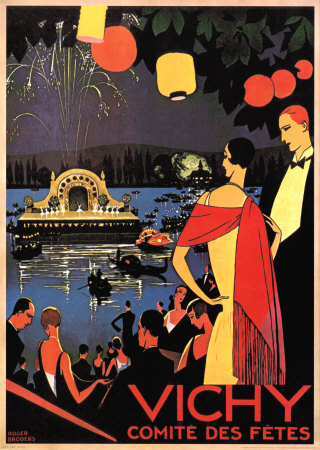Vodable
and the Dauphiné d'Auvergne
Because
of the delayed flights, we spent only two nights instead of three in a small
village called Vodable, in a region
historically known as the Dauphiné d'Auvergne. That was a shame, because
it was a very picturesque area, and the family with whom we stayed could not
have been more hospitable--or served more delicious meals!
The
village of Vodable was situated on the crest of a range of hills
overlooking a vast valley, so the views from the edge of it were incredible!
From Vodable, we drove north to Clermont-Ferrand, a big industrial city that is most famous as the headquarters of the Michelin Company but also remembered as the place from which the Crusades were launched in A.D. 1096. Matt did some research at the local archives. Meanwhile, Joe and Brian visited the old city of Clermont, including the eleventh-century church below, called the church of Notre-Dame-du-Port.
While staying at Vodable we also drove farther north to the town of Vichy. Vichy was a longtime resort town, built over hot springs, but is also remembered for having served as the capital of unoccupied France during the Second World War (the Germans had annexed northeastern France and occupied much of northern France, including Paris). There are lots of old mansions from the late nineteenth and early twentieth centuries and, of course, the hot springs. (The two pasts are not unrelated: it was because Vichy had been a resort town and had so many hotel rooms that it was chosen as the capital, since it had lots of room immediately available for government offices and employees.)

Left: the main hot springs building. Right: a poster advertising
Vichy from the early 20th century.
Near to Vichy is the town of Gannat, which has an odd connection to Saint Gerald. A legend, dating probably only from the seventeenth or eighteenth century, says that a nobleman named Gerald wanted to marry a young women named Procule. She wanted to remain a virgin dedicated to Christ, but he continued to pressure her to marry him, as did her parents, so she fled to escape him. He followed after her, and at Gannat he caught up to her. She avoided him once by being miraculously hidden by a large boulder, but he found her again in front of the church, and cut off her head. In a second miracle, she picked up her head and walked into the church before dying. He immediately regretted his anger, and fled himself to the monastery of Aurillac (founded by Saint Gerald), where he became a monk. The feastday for Ste. Procule (a saint not officially recognized by the Catholic Church) is the same as that of St. Gerald, October 13.
The chapel built near the miraculous boulder that sheltered
Ste. Procule.
Center: the church
of Ste.-Procule in Gannat. Left: a stained-glass image of St. Gerald of Aurillac
in the church.
Right: a stained-glass image of Ste. Procule in the church, with her head in
her hands.
Not far from Vodable itself is another tiny village, called Dauzat-sur-Vodable, that is also home to a church dedicated to Saint Gerald. This is one of the oldest of the Saint Gerald churches still in existence: it dates from the twelfth century. It also has an impressive setting. It was also locked up tight. Matt spoke with a local resident, who said that the church is no longer open because antiques dealers have stolen art objects from it--and, we found out, the same is true for many churches in rural France that have lost a lot of their artistic treasures.
Also
near to Vodable is the town of Issoire, where there is a beautiful
example of a Romanesque church, dedicated to Saint Austremoine,
who is said to have converted the Auvergne region to Christianity.
Click here to go to the next page.
Click here to return to the main menu and the map of France.